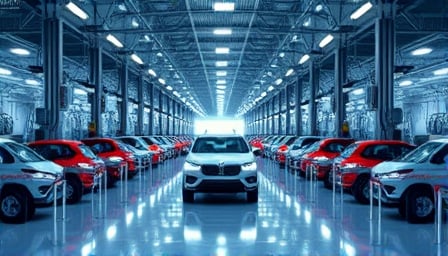Stellantis NV: A Calculated Surge Amid Recalls, Debt, and Controversy
Stellantis NV, the global juggernaut that commands both passenger and commercial vehicle markets, is once again in the spotlight—this time for a mix of bold moves and hard‑hit setbacks. The Italian‑based conglomerate’s latest press releases reveal a company that is aggressively expanding, recklessly navigating recalls, and strategically raising capital, all while juggling high‑profile legal entanglements that threaten its public image.
Resurrecting Windsor: A Return to Three‑Shift Operations
In a move that has already earned the approval of Unifor, the union that represents Windsor’s workforce, Stellantis is set to re‑launch its Windsor Assembly Plant under a three‑shift regime in the first quarter of 2026. The decision is more than a staffing shuffle; it signals the company’s commitment to reclaiming production capacity that was previously curtailed by labor disputes and a pandemic‑era slowdown. The new shift pattern is expected to boost output by up to 20 % and re‑energize a plant that has become emblematic of the American auto industry’s resilience.
Recalls that Undermine Confidence
Yet this resurgence is tainted by a wave of recalls that could have been avoided. Over 90,000 Jeep Grand Cherokee plug‑in hybrids in the United States and a substantial Canadian cohort are being pulled from the road due to software glitches that may trigger sudden loss of propulsion. The defects, which could precipitate crashes, expose a systemic flaw in Stellantis’ quality assurance processes. Critics argue that these recalls erode consumer trust and expose the company to costly litigation—an affront to the very “positive development” the firm touts.
Debt‑Backed Growth: The Three‑Part Bond Issue
In a decisive effort to shore up its balance sheet, Stellantis has announced a tranche‑structured high‑grade bond issuance. The three‑part deal is designed to raise capital for research, development, and expansion without diluting equity. While bondholders welcome the yield, skeptics point out that the company’s debt profile is already substantial, and any further leverage could constrain future investment in electrification and autonomous technology.
Advocacy for Regulatory Flexibility
CEO John Elkann has taken a public stance on European policy, urging the European Union to relax regulations for electric vehicles and to extend CO₂ reduction timelines. Elkann’s argument is that rigid rules stifle innovation and inflate production costs. Though the call has drawn support from some industry voices, environmental groups counter that flexibility could delay the EU’s climate goals, undermining the continent’s leadership in sustainable mobility.
The Gianni Agnelli Inheritance Dispute
Stellantis’ high‑profile CEO is no stranger to controversy. The settlement over the late Gianni Agnelli’s estate—under which Elkann agreed to perform community service—has been hailed by some as a mature resolution that lets him refocus on corporate strategy. Yet the episode underscores how personal affairs can spill into corporate governance, casting a lingering shadow over the company’s public perception.
Expanding Global Footprint: The Tofaş Contract
Diversifying its production portfolio, Stellantis signed a €256 million contract with Tofaş, a prominent Turkish automaker, to manufacture a new line of light commercial vehicles. This partnership not only expands Stellantis’ manufacturing footprint into the rapidly growing Turkish market but also positions it to better serve emerging economies where demand for efficient, affordable commercial vehicles is soaring.
Conclusion
Stellantis NV exemplifies the paradox at the heart of modern automotive conglomerates: a relentless drive for growth and market dominance shadowed by operational missteps, regulatory challenges, and public scrutiny. While the company’s recent initiatives—revamping Windsor, securing new financing, and forging international partnerships—demonstrate strategic acumen, the lingering recalls, debt burdens, and policy disputes serve as stark reminders that success in the automotive sector is as much about managing risks as it is about seizing opportunities. The world will watch closely to see whether Stellantis can translate its ambitious plans into sustainable, reliable performance that earns the trust of consumers, regulators, and shareholders alike.
